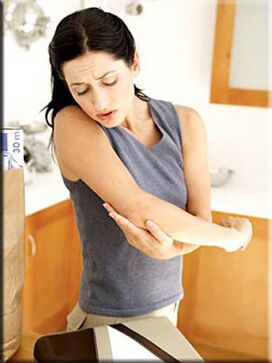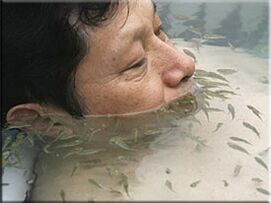Psoriasis can manifest in various forms.Psoriasis options include vulgar psoriasis (simple, ordinary) or, otherwise plate (vulgar psoriasis, plate psoriasis), pustular psoriasis, falling psoriasis or psoriasis, flexor psoriasis) (flexural psoriasis).This section provides a brief description of each variety of psoriasis, along with its code according to the International Classification of Diseases (ICD-10).

Plush psoriasis, or Common psoriasis, vulgar psoriasis, simple psoriasis (vulgaris psoriasis) It is the most common form of psoriasis.It is observed at 80% - 90% of all patients with psoriasis.Pellet -shaped vulgariasis manifests more often in the form of typical high areas on the surface of the healthy skin of inflamed, red and warm skin covered with gray or silver skin, easily exfused, scaly, dry and thickened.The red skin under a gray or silver layer easily removed is easily injured and bleeding as it contains a large number of small vessels.These areas of typical psoriatic damage are called psoriatic plates.Psoriatic plates tend to increase in size, merge with neighboring plates, forming the whole plate ("paraffin lakes").
Psoriasis of flexion surfaces (flexural psoriasis), or "Reverse psoriasis". It usually seems smooth, not peeling or with minimal red -fiery points that are not particularly protruding above the surface of the skin, located exclusively on skin folds, absence or minimal lesion of other areas of the skin.Most of the time, this form of psoriasis affects folds in the external genital organs, the groin, the inner surface of the hips, axillary depressions, doubles under a stomach obesity (psoriatic pannus) and the folds of the skin under the mammary glands in women.This form of psoriasis is especially susceptible to deterioration under the influence of friction, skin injury and sweat, and is often accompanied or complicated by a secondary fungal infection or streptococcal pyoderm.
Guttate psoriasis (guttate psoriasis) It is characterized by the presence of a large amount of small, high above the surface of healthy, dry, red or purple skin (to purple color), similar to drops, tears or small points, circles of the lesion elements.These psoriatic elements usually strengthen large surfaces of the skin, the most frequently hips, but can also be observed in the legs, forearms, shoulders, head winding, back, neck.Earth -shaped psoriasis usually develops or exacerbates after streptococcal infection in typical cases - after streptococcal tonsillitis or streptococcal pharyngitis.
Psoriasis pustular or Exudation psoriasis It is the most severe of psoriasis skin shapes and looks like bubbles or bubbles raised above the surface of the healthy skin, full of inflammatory and transparent inflammatory exudate (pustules).The skin under and above the surface of the pustules and around it is red, hot, edematosa, inflamed and thickened, exfoliates easily.Secondary pustule infection can be observed;In this case, the exudate acquires a purulent character.Pustular psoriasis can be limited, located, while its most frequent location are the distal ends of the limbs (arms and legs), ie the leg and forearm, this is called palmlate pustules (palmoplantar pustulosis).In other more severe cases, pustular psoriasis can be widespread, with widespread spread of pustules throughout the body's surface and the tendency to merge into larger pustules.
The causes of psoriasis
Function of impaired skin barrier (particularly mechanical trauma or irritation, friction and pressure on the skin, soap abuse and detergent, solvent contact, domestic chemicals, solutions containing alcohol, the presence of infected outbreaks in skin or skin allergy, excessive dry skin) also play a role in psoriasis development.
Psoriasis - This is, in many ways, an idiosynratic skin disease.The experience of most patients suggests that psoriasis can improve spontaneously or, conversely, aggravate for no apparent reason.Studies of various factors associated with the emergence, development or exacerbation of psoriasis are tended to be based on the study of small, usually hospital (non -outpatients), ie obviously more groups of patients with psoriasis.Therefore, these studies usually suffer from insufficient sample representation and the inability to identify causal relations in the presence of a large number of other factors (still unknown or unaffected) that may influence the nature of the psoriasis course.Frequently, in different studies, contradictory findings are found.However, the first signs of psoriasis usually appear after stress suffered (physical or mental), skin damage to the places of the first appearance of psoriatic rashes and/or transfered streptococcal infection.Conditions, according to various sources that may contribute to the exacerbation or worsening of the psoriasis course, include acute and chronic infections, stress, climate change and change of stations.Some drugs, in particular, lithium carbonate, beta -peloqueers, antidepressants, antimalic drugs, anticonvulsants, according to various sources, are associated with a deterioration in psoriasis or may cause its primary occurrence.Excessive alcohol consumption, smoking, overweight or obesity, inadequate nutrition may consider the psoriasis course or complicate its treatment, cause exacerbations.Hair varnish, some hands and hand straps, cosmetics and perfumes, household chemicals can also cause psoriasis exacerbation in some patients.

Patients suffering from HIV infection or AIDS usually suffer from psoriasis.This seems to be paradoxical for psoriasis researchers, as treatment designed to reduce the number of T cells or their activity usually helps treat psoriasis, and HIV infection or, moreover, AIDS is accompanied by a decrease in T -cell number.Circulating, psoriasis in HIV -infected patients or worsening AIDS patients.In addition to this puzzle, HIV infection is usually accompanied by a strong change in the cytokine profile compared to TH2, while vulgar psoriasis in uninfected patients is characterized by a strong change in the TH1 cytokine profile.According to the hypothesis currently adopted, a reduced amount and pathologically altered activity of CD4+ T lymphocytes in patients with HIV or AIDS infection cause CD8+ T's T lymphocyte hyperactive, which are responsible for the development or aggravation of HIV psoriasis or patients with aid.However, it is important to know that most patients with psoriasis are healthy in relation to HIV transport, and HIV infection accounts for less than 1 % of cases of psoriasis.On the other hand, psoriasis in people infected with HIV occurs, according to various sources, with a frequency of 1 to 6 %, which is approximately 3 times higher than the frequency of psoriasis in the general population.Psoriasis in patients with HIV infection and especially AIDS usually remains extremely difficult, and is not borrowed or not subject to standard therapy methods.
Psoriasis most often develops in patients with initially dry, thin and sensitive skin than in patients with oily skin or good -e -and is much more common in women than in men.In the Same Patient, Psoriasis Most Often First Appears in Areas of Dry or Thinner Skin Than in Oily Skin, and Specially Often Appears in Places of Damage to the Skin, Including Combing, Abrasions, Scratches, Cuts, In Places Undergoing Friction, Pressure or Contact with contact withAggressive Chemicals, detergents, detergents, and detergents, solutions, solutions, solutions.(This is called the Kebner phenomenon).It is assumed that this psoriasis lesory phenomenon is mainly with dry, thin or injured skin associated with infection with the fact that the body infects (probably most often Streptococcus) easily penetrates the skin with minimal skin fat secretion (which, under other conditions, protects the skin from infection) or in the presence of damage to the skin.The most favorable conditions for psoriasis development are therefore opposed to the most favorable conditions for the development of fungal feet infection (the “athlete's leg” called) or armpits, the inguinal region.For the development of fungal infections, the most favorable and wet skin,For psoriasis, on the contrary, the infection that has penetrated the dry skin causes chronic dry inflammation (not expressed), which in turn causes characteristic symptoms of psoriasis, such as itching and increased skin cell proliferation.This, in turn, leads to increased dryness of the skin, both due to inflammation and the improved proliferation of keratinocytes and the fact that the infected body consume moisture, which would otherwise serve to moisturize the skin.To avoid excessive skin dryness and reduce psoriasis symptoms, patients with psoriasis are not recommended to use cloths and exfoliators, especially rigid, as they not only damage the skin, leaving microscopic scratches, but also scrape the skin from the corneal and upper skin, which protect the skin from the drought from the drought and the pen.It is also recommended to use a talc or smoker baby after washing or bathing to absorb excess skin moisture, which, otherwise, "will receive" an infected agent.In addition, it is recommended to use products that moisturize and feed the skin and lotions that improve the function of the sebaceous glands.It is not recommended to abuse soap, detergents.You should try to avoid contact with the skin with solvents, home chemicals.
Psoriasis diagnosis
The diagnosis of psoriasis is usually simple and based on a characteristic appearance of the skin.There are no diagnostic procedures or blood tests specific to psoriasis.Nevertheless, with Active, Progressive Psoriasis or ITS Severe Course, Deviations in Blood Tests Can Be Found, Confirming the Presence of An Active Infummory, Autoimmune, Rheumatic Process (Increating the Titles of Rheumatoid Factor, Acute Phase Proteins, Leukocytosis, IncreasedESR, etc.), the wells As Endocrine and Biochemical Disorders.Sometimes a skin biopsy is required to exclude other skin diseases and histological confirmation (verification) of psoriasis diagnosis.During a biopsy of the patient with psoriasis, cluster of the so-called retail tears, thickening of a layer of keratinocytes, their histological immaturity, massive skin infiltration with T lymphoos, macrophy and dendritic cells, signs of increased kerathinocimation, frigids and dendritics, signs of proliferation of proliferationKeratinéns, layer of skin under the skin under a layer of skin under a layer of skin under a layer of skin under a layer of skin under a layer of skin under a layer of skin under downs.Another characteristic sign of psoriasis is punctual hemorrhage and the ease of bleeding skin under the license plate during its slavery, which is associated with the acceleration of angiogenesis and pathologically increased and brittle skin vessel permeability in the lesion (Aushpitz symptom).
Alternative treatment of psoriasis
For symptomatic treatment of vulgar psoriasis, some of the countries in some countries use ictotherapy in some open -spring resorts.The claw fish that live there eat the skin on psoriatic plates, without touching healthy areas.After this treatment, an improvement in patients' condition is observed in six months or more.A successful place in subtropics allows you to combine comfortable hotel rooms with fish spa and sea bath procedures.At your request, the hotel cook will prepare a special diet.Water in a bath with the claw fishing fish passes a three -stage cleaning system (mechanical, ultraviolet sterilization in execution and biological purification).The sun, the sea, the fresh air, the special diet this in the complex helps to achieve a positive effect of miracle fishing baths.Daily sprinkle with a mixture of powdered sugar and potato starch will help remove psoriatic plates.
Treatment of psoriasis with folk remedies
- To deal with psoriasis, Give up fat, pork, smokers, chocolate, spices, alcohol, coffee and sweets.Enrich the diet with fermented dairy products, fresh herbs, baked apples, fish salads and nettle.Eat many vegetable oils rich in indispensable fatty acids) and products containing lecithin.
- Eating food In boiled, boiled or boiled (fried and smoked) of the diet.
- Refuse foods that increase body acidity- Give preference to products that flag the body.Some people on the web repeatedly witness that only a change in nutrition in the direction of the alkalization contributed to the complete restoration of health, not only of psoriasis itself but also from ancient chronic diseases.
- To wash Only children or tar soap, taking bathrooms regularly with celandine decoctions, hops and three -color violets.
- Follow Surgery (hunger 1 to 2 days).























